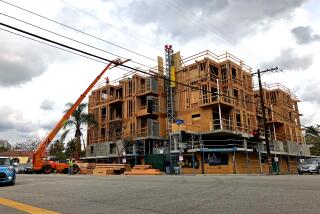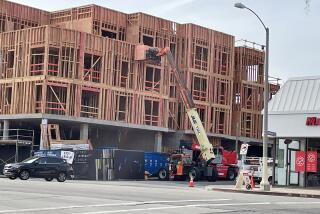Bell Enacts Limit on Residential Density : Growth: New ordinance to take effect Feb. 7 also will double the amount of open space, including parks, in high-density areas.
- Share via
BELL — The City Council, faced with mounting problems caused by a population explosion that is threatening to overwhelm vital community services, voted this week to reduce the number of residences that can be built in high-density areas of the city.
Despite protests by real estate agents and developers, the council voted 3 to 1 to reduce the number of multifamily residences, such as apartments, townhouses and condominiums in high-density areas from 21.78 per acre to 18.94 per acre. The amendment also doubles the amount of open space, such as parks, that must be provided.
Until the changes go into effect Feb. 7, there will be an extension of the year-long moratorium on building in high-density areas that was to expire Tuesday.
According to the Los Angeles County Department of Regional Planning, Bell is the 15th most densely crowded city in the county, with 10,104 people per square mile. In a 1985 survey, it ranked among the 10 poorest cities in the county with a per capita income of $6,495. “This city has to come to grips with the growth that already has taken place,” Councilman George Cole said at the meeting. “We can see the outcome in terms of people. We can see the possibility of crime going up, the possibility of children not having parks to play in. At some point or other you have to dig in your heels.”
Several real estate brokers and developers have argued that fewer residences does not necessarily mean fewer people. To developers, the amendment translates to one residence per 2,300 square feet. In the past they were allowed to build one home per 2,000 square feet. This means that developers will now have to build three homes instead of four on lots that are 8,000 square feet or larger.
Pedro Rua, a private developer based in Whittier, said that reducing the number of dwelling units per lot would discourage developers from coming into the area.
“We won’t even be coming in here to build,” Rua said. “If we do, we are talking about $400,000 per home. There are no people in this area who will buy a home that expensive. This is a low-income area.”
Marina Martin, a real estate broker who sat on a special committee formed this spring to help the Planning Department come up with solutions, said the problems of high density would have been better addressed if more smaller houses were built.
“Now if you build one big three-bedroom house, you are going to get two families moving into it,” Martin said.
Adolfo C. Reta, director of community development, agreed that the amendment is not going to reverse the problems of density, but he said that in the next few years it will lessen its severity.
“It’s a step in the right direction,” Reta said. “It’s not the solution. The bottom line is not so much density. The fact is the infrastructure--the sewer systems, water, traffic--is so bad and it’s getting worse. We have no money to spend to fix sewer systems. Even if we stopped all development, I don’t think we can maintain this level of service for too many years. The fact is more housing does generate more use of the infrastructure.”
Reta said that 82% of the residentially zoned lots in Bell range between 5,000 and 8,000 square feet. Only building on lots larger than 8,000 square feet and zoned for multifamily residential use, will be controlled by the new zoning ordinance. What it all boils down to, Reta said, is that only 20% of approximately 3,073 lots in town will be affected.
“Real estate people have the impression that many more lots are going to be affected,” Reta said. “They are not. But if the city doesn’t take a stand at trying to reduce the influx of people, then sometime in the future we are going to have a tremendous problem.”
The City Council imposed a moratorium a year ago after acting Planning Director William Phelps warned that the increase in residents had placed “unprecedented pressure on the outdated, undersized, inadequate community facilities.”
More to Read
Sign up for Essential California
The most important California stories and recommendations in your inbox every morning.
You may occasionally receive promotional content from the Los Angeles Times.










